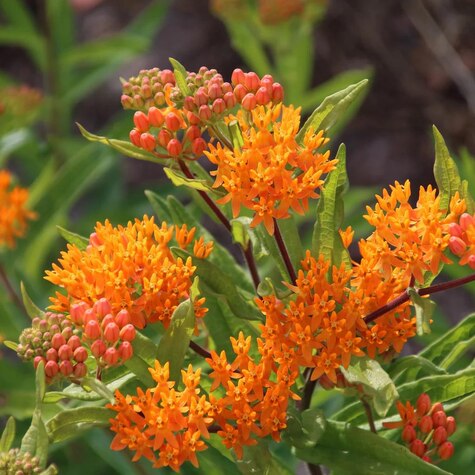Milkweed
by CMG Kathleen S.
Milkweed has gone from an obscure weed to the forefront in the fight to save monarch butterflies. It’s the host plant for the monarch butterflies. That means it is the depository plant for their eggs. Once hatched the plant provides food for the larvae and nectar for the butterfly.
Milkweed belongs to the genus Asclepias. There are two major categories: Native and Tropical. Both plant categories can contain a parasite named Ophryocystis elektroscirrha (OE). Ingesting this parasite makes it difficult for the monarch butterflies to fly and decreases their lifespan. Native milkweed will die off in the fall and the parasite dies with the plant therefore controlling the parasite.
Tropical milkweed (Asclepias currasavica) can be an evergreen plant in areas with temperate winters. If it does not die back in the fall, it will provide a haven for the OE parasite. Additionally, with a constant supply of food, monarch butterflies are less inclined to migrate to warm winter climates. Non-migrating colonies have become more frequent along the southeast coast of the US. Those butterflies are susceptible to death from severe weather and hard freezes.
In general, milkweed is a fast growing plant reaching heights of 2 to 4 feet. Its name derives from the milky white substance in the stem and leaves. Cardenolide chemicals produced by the milkweed are ingested by the monarch butterflies which in turn make them toxic to predators. All parts of the milkweed plant are poisonous to humans, pets and many types of livestock.
Milkweed can spread very quickly by rhizomes underground which can create an unkempt appearance. They also self-seed. It is best planted by itself or in a naturalized area. Milkweed does not need fertilizer and is tolerant of dry conditions. Overwatering can encourage a leaf spot fungal disease. Milkweed requires 6 to 8 hours of sunlight and is not very happy with extreme heat or humidity.
There are 30 varieties of milkweed native to Texas. Antelope Horns Milkweed (Asclepias asperuia) is found mostly in the Texas Hill Country through West Texas where it grows in ditches and open pastures. It grows 1 to 3 feet tall and blooms from early spring until fall. The flowers appear as tennis ball sized clusters of white with dark red edged flowers. The resulting seed pods resemble antelope horns, hence the name. Aphids can be a problem. Blasting off the aphids with a garden hose and lady bugs are effect controls. This plant is very toxic for sheep.

Green Milkweed from NationalWildlifeFederation.com
Green Milkweed (Asclepias viridis) is found from East Texas to the Edwards Plateau. It will grow 1 to 3 feet tall in a variety of soils. Blooms occur in late spring to mid-summer and are pale green with purple hoods. It is mostly pest and disease free. Green milkweed is very toxic to horses.

Tropical Milkweed from ProvenWinners.com
Tropical Milkweed is native to South America. It is popular with plant growers due to the ease of propagation and provides an attractive plant for an easy sale. The plant grows 2 to 3 feet tall. Blooms are pretty with yellow hoods over orange-red blossoms that readily bloom from summer to fall. The plant prefers loamy and sandy soils and will grow in dry or wet conditions. It is very toxic to horses.

Butterfly Weed from HudsonValleySeed.com
Butterfly weed (Asclepias tuberosa) is native to Texas and is an alternative to tropical milkweed. It grows 1 to 2 feet tall. Blooms can be orange, yellow or reddish. It prefers dry, well-drained soil. This plant may take up to 3 years to bloom. It will die back in the fall and is dormant during the winter months. If the stalks and seed pods are left over the fall and winter, the plant will self-seed. Aphids can be controlled with blasts of the garden hose and ladybugs. The plant does not have “caustic” milky sap and is less toxic than the other milkweeds.
You can incorporate butterfly weed into your garden for a beautiful effect. Consider planting it with Liatris and other plants with blue and purple blooms. Yellow blooms like Black-eyed Susan are also an option. Alternatively, follow the Native Plant Society of Texas for gardening hints and plant availability. This past February, the Society hosted a milkweed sale with plants listed at $5 each. The Xerces Society is very involved in establishing milkweed waystations-butterfly gardens – and has a PDF download “Milkweeds- A Practitioners’ Guide”. This publication discusses large scale production of milkweed seeds; propagation and restoring plants in fields. There are YouTube videos on growing milkweed; starting milkweed from seed and transplanting milkweeds.
References: mcmga.com/Monarchs-and-milkweed/ (Texas A&M AgriLife); thespruce.com/milkweed-plants-monarch-butterfly-host-2132954; smithsonianmag.com/smart-news/how-popular-garden-plant-may-spread-monarch-parasite-18; www.en.wikipedia.org/wiki/Monarch-butterfly’; birdsand blooms.com/milkweed-guide; rangeplants.tamu.edu/plant/antelopehorn-milkweed’; txmg.org/hendersonmg/plant-library/milkweed-antelopehorns; gardenia.net/plant/asclepias-virdis; gardenia.net/plant/asclepias-curassavica; org/blog/tropical-milkweed-a-no-grow; thespruce.com/growing-butterfly-weed-in-your-garden-2539531
